Introduction
The dependency of Information technology (IT) can be seen in various scopes and functions in an organization in order to support their daily business functions. The organization will always ensure that their IT infrastructure is workable at any time. This is to ensure that there will be no transaction distortions and they will be able to achieve high return on investment (ROI), to some extent, some organizations are willing to spend some amount of money in order to ensure that their IT infrastructure is in tip top condition. IT infrastructure is classified into two (2), such technical (Duncan, 1995) and human IT infrastructure (Byrd & Turner, 2000 & 2001 & Chanopas, Krairit & Khang, 2006). In extend, Byrd & Turner (2000) and Duncan (1995) mention that technical IT infrastructure shall consist of the hardware and operating systems (platform technology), network technologies, data and application software. Meanwhile, human IT infrastructure is all about human and organizational skills, expertise, competencies, knowledge, commitments, values, norms and organizational structure (Byrd & Turner, 2000). However, Fink & Neumann (2009) developed a multidimensional definition of IT infrastructure where with addition of process IT infrastructure. Thus, they had identified a range of physical and managerial capabilities as the dimensions under this concept.
The demands of using IT infrastructure force it to be flexible to their user whenever required. To become flexible, IT infrastructure shall cater for all three (3) concepts mentioned above accordingly. Yearly studies and papers done produced a report on this concept across disciplines. In the beginning studies conducted by Duncan (1995), Chung, Rainer & Lewis (2003), Fink & Neumann (2009), Byrd & Turner (2000 & 2001), Zhang & Ziegelmayer (2009), Chung et. al. (2005), Bush, Tiwana & Rai (2010), Sirkemaa (2002), Bhatt et al. (2010), Masrek & Jusoff (2009), Zainon & Salleh (2011) etc., found four (4) dimensions: compatibility, modularity, connectivity and IT personnel that had been discussed throughout the years. However, studies by Gholami, Kaviani & Zabihi (2003) and Chanopas, Krairit & Khang (2006) found additional five dimensions: scalability, continuity, rapidity, facility and modernity.
An organization may use either Electronic systems (e-commerce) or Mobile commerce systems (m-commerce); Transaction Processing Systems (TPS); Management Information Systems (MIS); and Decision Support Systems (DSS) to support their business operation and to achieve their business goals and all these are examples of Information systems (IS). Limited studies have been conducted on strategic use in the context of IS. Masrek, Jamaludin & Hashim (2009) proposed conceptual framework for studying the effect of technological, organizational and environmental factors on the strategic utilization of information systems. Meanwhile, unpublished thesis by Jamaludin (1996) was investigating factors that influence the strategic utilization of information resources (SUIR). Thus, both studies introduced dimensions such as product differentiation, cost leadership and growth advantage as part of the concept of the strategic use of IS.
Overall, in this systematic review, the researchers intended to find the following objectives:
- To structuring the overview of strategic utilization of information systems.
- To structuring the overview of IT infrastructure flexibility.
The rest of this paper is as follows. Section 2 introduces the research methodology. Section 3 provides the systematic review findings. Section 4 ends the paper with a discussion and conclusion.
Methodology
At the beginning of getting the idea about the topic, researchers are doing traditional or conventional way of literature review. The process of searching, collecting and reading those literatures in getting glasses or surface idea about the research topic is sufficient at that point of time. To streamline further as which concept, variables and dimensions to choose, systematic review was found to be suitable in this study.
To create maximization and optimization in new and existing literature collections, we adopt the work from (Cooper & Hedges, 2009) and it is widely used i.e. (Kobus & Westner, 2015). Table 1 shows the stages of systematic review.
Table 1: Stages of Systematic Review
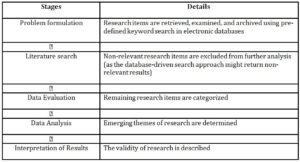
Literature Retrieval
In the process of searching and retrieving, this study focused on peer-reviewed journals and conferences on selected online databases that have been decided earlier. List of searches focus by online databases is shown in Table 2.
Table 2: Searching Focus by Online Databases

Upon deciding which online databases to use, the researchers set several phrases to use during the searching process. The phrase is based on the theme that reflects the concept of this study. For the journals and conference papers or proceeding papers, the searching was derived not using any solid keywords, combination of keywords and string such AND, OR, “”, ‘-‘, ‘+’ etc. In this case, the researchers prefer more to use phrases that reflect the topic of the study. For the first (1st) and second (2nd) iteration, the researchers use phrases that related to the independent variable (IV) while the phase that related to the dependent variable (DV) was during the third (3rd) iteration. Thus, the searching was done three (3) iterations with different phases. Below is the list of phrases that researchers used in this study:
Table 3: The List of Phases Used during the Searching
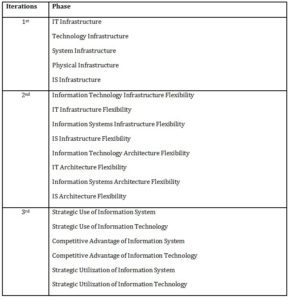
Literature Exclusion
In this systematic review searching or query, the researchers do not eliminate the use of abbreviation of certain words such as “IT” for Information Technology and “IS” for Information System and this also had been done by (Kobus & Westner, 2015).All words and abbreviations are used to give a higher probability of getting any closer journal or conference papers or proceeding papers that most matched the searching.
No matter which online databases are used, the same search strategy was applied across these three (3) iterations. Whenever there were no results, another or broader phrase search was used as shown in Table 3. The extensive use of broader keyword is necessary during the searching. After all, any journal or conference papers or proceeding papers were excluded when the researchers found them not relevant for the study. According to (Kobus & Westner, 2015), all these journal or conference papers or proceeding papers can be considered not relevant whenever at least one of the following criteria was applied:
Table 4: Criteria in Filtering the Searching

Literature Categorization
After applying the above criteria as in Table 4, leaving 472 journals or conference papers or proceeding papers to proceed with the literature categorization. All relevant and matched journal or conference papers or proceeding papers were kept and managed accordingly. Each group of phase that had been set earlier was used at each online database. Upon filtering and exclusion, each literature was managed and labelled respectively by dedicated folder as illustrated in figure 2 below:
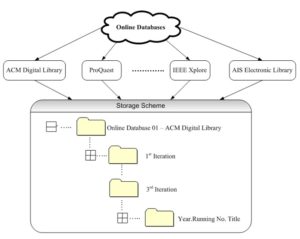
Figure 1: Literature Management
The next phase is extracting the key point at each literature. The main purposes are to identify the dimensions of strategic utilization of information systems and the dimensions of IT infrastructure flexibility. In order to capture and identify those dimensions, the researchers follow (Dibbern, Goles, Hirschheim and Jayatilaka, 2004) as also adopted by (Kobus & Westner, 2015) and little enhancement has been made. Originally, the categorization of items is reference theory; research approach; research type; data gathering and data analysis. Field of the literature and country has been add-up with this note taking.
Results
Descriptive Analysis: Selection of Relevant Literature
The search resulted in a total of 472 journals or conference papers or proceeding papers that were extracted for three consecutive months and the breakdown by iteration is shown in Table 5. All this literature is initially in scope for literature review. On top of that, all these literatures were examined and analyzed their relevancy in order to identify the dimensions of strategic utilization of information systems and the dimensions of IT infrastructure flexibility.
Table 5: The Breakdown by Iteration
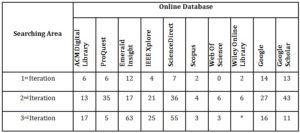
* Pdf file cannot open
The Dimensions of Variables
Using the literature categorization by (Dibbern, Goles, Hirschheim and Jayatilaka, 2004), researchers were able to identify every dimension respectively. As mentioned above, the first (1st) and second (2nd) iteration were searching the independent variable (IV) while the dependent variable (DV) was during the third (3rd) iteration. At first, researchers used the generic template or form to fill-up information according to the literature categorization. Based on this form, researchers transforms into a table and diagram (was inspired and shared by one of the friends in the Facebook Doctorate Support Group) which appropriate to get a clearer picture on the selection of the dimensions. The summary of the DV is shown in Figure 4 and the IV is shown in Table 6 respectively. The results show only some part or most prominent authors and not from all literatures. With the use of systematic review exercise, it helps researchers a lot in framing and confirming which dimensions to use for the study.
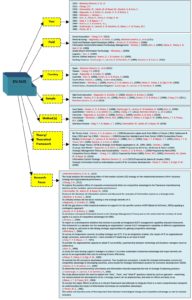
Figure 2: The Summary of Dimension for the Dependent Variable (DV)
Table 6: The Summary of Dimension for the Independent Variable (IV)
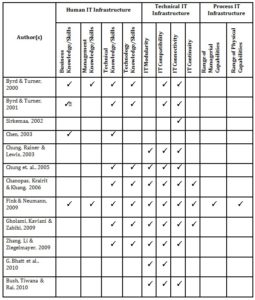
Discussion & Conclusion
The selection of the dimensions for the DV and IV was basically derived from the results of the systematic review conducted. By doing the systematic review, researchers get clearer picture on the evolution of each variable; which field has adapted and adopted the concept; what type of methodology that other researchers did etc. To understand the whole concepts of the study, researchers need 360 degree view about it. The motivation of the study was captured too through this systematic review.
The hassle in doing systematic review is where the researchers required capturing every single process involved. Moreover, the researchers also shall be able to identify important components or section in articles they read and note it down. This is due to some articles that discussed the dimension in narrative methods while others prefer in schematic way. Currency and relevancy are a part of criteria to look into while choosing those dimensions for the DV and IV at the end. Perhaps, this approach also shall be able to search and identify the reasons behind all “how” and “why” in the study.
The approach or method used here best suits any who will like to undergo quantitative study. It is important to identify first the IV and DV involved between concept where no matter what researchers will like to find out in their study which either to measure the difference, correlation or factors that influence between concept.
Based on the systematic review conducted, the choice of these dependent variables to form the framework is taken from the previous works by (Masrek, Jamaludin & Hashim, 2009; Jamaludin, 1996), which are product/service differentiation; cost leadership and growth advantage. While for the independent variable, this study will measure the dimensions of IT infrastructure flexibility, such as Human, Technical and Process IT infrastructure (Masrek, Jamaludin & Hashim, 2009; Jamaludin, 1996; Hilhorst, Ribbers, Heck & Smits, 2008; Duncan, 1995; Chung, Rainer & Lewis, 2003; Fink & Neumann, 2009; Byrd & Turner, 2000; Byrd & Turner, 2001; Zhang, Li & Ziegelmayer, 2009; Chung et al., 2005; Bush, Tiwana & Rai, 2010; Sirkemaa, 2002; Bhatt et al., 2010; Masrek & Jusoff, 2009; Zainon & Salleh, 2011; Gholami, Kaviani & Zabihi, 2009; Chanopas, Krairit & Khang, 2006) etc.
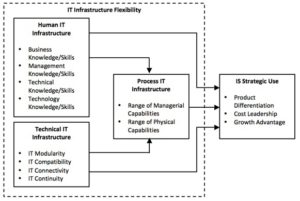
Figure 3: Conceptual Framework
Acknowledgment
This research was supported in part by the Ministry of Higher Education (MOHE) and the Research Management Institute (RMI), Universiti Teknologi MARA (UiTM) for funding the research project [ref. no. 600-RMI/RAGS 5/3 (142/2012)] and Hazirah Abdul Karim from Facebook Doctorate Support Group for sharing the problem statement and/or literature review in diagram.
(adsbygoogle = window.adsbygoogle || []).push({});
References
- Avram, D. O. & Kühne, S. (2008). “Implementing responsible business behavior from a strategic management perspective: Developing a framework for Austrian SMEs”, Journal of Business Ethics, 82, 463–475.
Google Scholar
- Bush, A. A., Tiwana, A. & Rai, A. (2010).“Complementarities Between Product Design Modularity and IT Infrastructure Flexibility in IT-Enabled Supply Chains,” IEEE Transactions on Engineering Management, 57(2), 240-254.
Google Scholar
- Bhatt, G. et al. (2010). “Building and leveraging information in dynamic environments: The role of IT infrastructure flexibility as enabler of organizational responsiveness and competitive advantage,” Information & Management, 47, 341–349.
Google Scholar
- Byrd, T. A. & Turner, D. E. (2000). “Measuring the Flexibility of Information Technology Infrastructure: Exploratory Analysis of a Construct”, Journal of Management Information Systems, 17(1), 167-208.
Google Scholar
- Byrd, T. A. & Turner, D. E. (2001). “An Exploratory Analysis of the Information Technology Infrastructure Flexibility Construct”, Information & Management, 39, 41-52.
- Chanopas, A., Krairit, D. & Khang, D. B. (2006). “Managing information technology infrastructure: a new flexibility framework”, Management Research News, 29(10), 632-651.
Google Scholar
- Chung, S. H., Rainer, R. K. Jr. & Lewis, B. R. (2003). “The impact of information technology infrastructure flexibility on strategic alignment and applications implementation,” Communications of the Association for Information Systems, 11, 191-206.
Google Scholar
- Chung, S. H. et al. (2005).“An empirical study of the relationships between IT infrastructure flexibility, mass communication and business performance,” The database for advances in Information Systems, 36(3), 26-44.
Google Scholar
- Cooper, H. & Hedges, L.V. (2009). “Research synthesis as a scientific process”,The Handbook of Research Synthesis and Meta-Analysis, 2, 3 – 17.
Google Scholar
- Daniels, S. (1998). “The strategic use of information systems”, Work Study, 47 (5), 167 – 171.
Google Scholar
- Dibbern, J., Goles,T., Hirschheim, R. and Jayatilaka, B. (2004). “Information sytems outsourcing”, ACM SIGMIS Database, 35 (4), 6 – 10.
- Duncan, N.B. (1995). “Capturing flexibility of information technology infrastructure: a study of resource characteristics and their measure”, Journal of Management Information Systems, 12(2), 37-57, 1995.
Google Scholar
- Dreyer, B. & Grønhaug, K. (2004). “Uncertainty, flexibility, and sustained competitive advantage”, Journal of Business Research 57, 484–494.
Google Scholar
- Fink, L. & Neumann, S. (2009). “Exploring the perceived business value of the flexibility enabled by information technology infrastructure”, Information & Management, 46, 90-99.
Google Scholar
- Gebauer, J. & Schober, F. (2006). “Information system flexibility and the cost efficiency of business processes”, Journal of the Association for Information Systems, 7 (3), 122-147
Google Scholar
- Gholami, B. Kaviani, F. & Zabihi, E. (2009). “Web 2.0, a boost in it infrastructure flexibility and team collaboration,” 2009 Second International Conference on Computer and Electrical Engineering, 153-157.
Google Scholar
- Henderson, J. C. & Venkatraman, N. (1999). “Strategic alignment- Leveraging IT for transforming organizations”, IBM Systems Journal, 32 (1), 472 – 484.
- Hilhorst, C., Ribbers, P., Heck, E. V. & Smits, M. (2008).“Using Dempster–Shafer theory and real options theory to assess competing strategies for implementing IT infrastructures: A case study”, Decision Support Systems, 46, 344–355
Google Scholar
- Jamaludin, A. (1996). “Penggunaan strategik sumber maklumat (PSSM)”, Unpublished thesis. Universiti Sains Malaysia (USM).
- Kehoe, D., Little, D. & Lyons, A. (1993).“Strategic planning for information systems enhancement”, Integrated Manufacturing Systems, 4(2), 29-36.
Google Scholar
- Kerr, A. (1990). “Information technology: Creating strategic opportunities for logistics”, Logistics Information Management, 3(3), 18-20.
- Kobus, J. & Westner, M. (2015). “Lean management of IT organization: A literature review”,PACIS 2015 Proceedings. Retrieved at http://pacis2015.comp.nus.edu.sg/_proceedings/PACIS_2015_submission_242.pdfon 20 July 2015.
- Leek, C. (1997).“Information systems frameworks and strategy”, Industrial Management & Data Systems, 97 (3), 86 – 89.
Google Scholar
- Leeuw, A. D. & Volberda, HW. (1996). “On the concept of flexibility: A dual control perspective”, Omega, International Journal Management Science, 24 (2), 121 – 139.
Google Scholar
- Masrek, M. N., Jamaludin, A. & Hashim, D. M. (2009).“Determinants of strategic utilization of information systems: A conceptual framework,” Journal of Software, 4(6), 591-598.
Google Scholar
- Masrek, M. N. & Jusoff, K. (2009). “The effect of information technology infrastructure flexibility on intranet effectiveness,” Computer and InformationScience, 2 (2), 57-67.
Google Scholar
- O’Shaughnessy, N. J. (1996). “Michael Porter’s competitive advantage revisited”, Management Decision, 34 (6), 12 – 20.
Google Scholar
- Porter, M. E. (1985).“Technology and competitive advantage”, Journal of Business Strategy, 5(3), 60-78.
Google Scholar
- Renken, J. (2004). “Developing an IS/ICT management capability maturity framework”. Proceedings of SAICSIT 2004, 53-62.
Google Scholar
- Scarbrough, H., Lannon, R., & Hamilton, R. (1986). “Strategy for information technology: One step beyond”, Industrial Management & Data Systems, 86(1/2), 2-4.
- Selig, F. F. & Nipper, J. T. (1991). “Strategic impact of information technology”, Industrial Management & Data Systems, 91(6), 3 – 4
Google Scholar
- Sirkemaa, S. (2002). “IT infrastructure management and standards,” Proceedings of the International Conference on Information Technology: Coding and Computing (ITCC’02).
- Zainon, N. & Salleh, H. (2011). “Dimensions of information technology infrastructure flexibility in improving management efficacy of construction industry perspective: A conceptual study,” African Journal of Business Management, 5 (17), 7248-7257.
Google Scholar
- Zhang, J., Li, H. & Ziegelmayer, J. (2009). “Resource or capability? A dissection of SMEs’ IT infrastructure flexibility and its relationship with it responsiveness,” Journal of Computer Information Systems, 46-53.
Google Scholar











